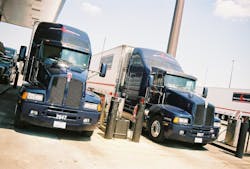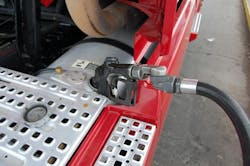As diesel and gasoline prices yet again are to be found on an upward track, fleets of all shapes and sizes are redoubling their efforts to find ways to reduce fuel expenditures.
Now, there are a ton of different ways to cut fuel expenses – the best being to improve vehicle fuel economy – yet how fleets by their fuel in the first place is one that often gets overlooked.So – along that line of thought – I asked Bill Cooper (seen at right), vice president of fleet sales with fuel-card provider Wright Express, for some advice on the subject of fuel buying strategies.
While some fleets may not agree with his take on the questions I presented to him below, at the very least, it’ll give fleets plenty of fuel for thought (no pun intended … well, OK, maybe a LITTLE bit of intention) when it comes to what types of fuel-buying strategies to deploy.
Q: Does the type of fuel a fleet buys dictate what kind of fuel buying strategy they should use? For example, is cost plus a better strategy for diesel, while retail minus works best for gasoline?
Cooper: Margins on diesel have historically been larger than on unleaded gasoline. While this means a true “cost-plus” program could be beneficial to a diesel fleet operator, the process to determine the best price scenario would remain the same.
If you are in a geographic area where diesel margins are compressed, a “retail-minus” program could be beneficial. Another fact to consider is there are more diesel locations throughout the U.S. other than the typical interstate truck stop location. You might have access to a diesel site on the corner, three miles before you reach the exit for the interstate. If the canopy height can handle your box truck, the pricing at the neighborhood station may be better than the location 40 miles down the interstate.
Regardless of the type of fuel, the single most important factor in determining if a cost plus program is cost effective for your business is: A) determining the “cost” basis your price will be calculated on and B) finding a source to benchmark the cost that is not reliant on the station or card program supplying you the fuel. Having to rely on your supplier for proof of savings is no different than a car dealership showing you how much you saved off of the sticker price on the new car!
Q: Does the style of operation dictate fuel procurement strategies as well? For example -- if a fleet is operating coast to coast across the U.S. should its fuel plan be different from a fleet that stays within a set region or localized area?Cooper: The short answer is yes. There are various factors that fleet managers should consider for their fuel procurement strategies. Retail margins, and thus prices, fluctuate daily, swinging significantly from region to region and brand to brand. Seasonal demand, weather emergencies, regulatory pressure, local competition, and, of course, volatility in the oil market can all push margins higher or lower.
There are three categories of margin markets that could affect fuel pricing and procurement:
- Low margin markets tend to be found in oil-producing states, such as those in the Gulf Coast, where fuel does not need to travel far to reach stations. Retail margins here average about 4 to 8 cents per gallon (CPG).
- In high margin markets, such as in California or Hawaii, gas must travel farther from terminals to reach fueling stations, meaning lessees must pay their dealers higher prices for fuel. These costs are passed along to customers. Stations in these areas might impose margins of upwards of 25 CPG.
- Mid-margin markets – such as in many parts of the Northeast – fall somewhere in between these two extremes.
Q: Many fleet managers try to find the lowest pump price and direct their drivers to it – is this a wise strategy from a strategic perspective?
Cooper: The price at the pump is a combination of several individual factors, dictated primarily by the cost of crude oil with the addition of other contributors including refinery costs, federal or state taxes, and distribution and marketing.
Each station chooses between retail minus or cost plus plan depending on how region and additional costs added to the station price. Due to preferences, for a fleet manager operating vehicles across many regions, the math begins to change in favor of retail minus vs. a pre-determined rack price by Oil Price Information Service (OPIS).
Fleet managers should not select pricing schemes based on “at-the-pump cost” alone because of the fact that pricing is always changing based on a variety of factors and might not be the most profitable fuel source in the long term. As little as one extraneous mile per month per driver can result in significant margin erosion across a large-scale fleet.Q: You believe “retail-minus” offers the best fuel pricing plan most of the time. Why is that?
Cooper: Generally, retail minus provides several benefits to fleet managers and drivers that is not offered through cost-plus.
First, “retail-minus” provides the best transparency to the pump price: the pump price is the pump price, no matter what. In today’s volatile markets and increasingly complicated regulatory environment, managers need a pricing structure that allows for self-reporting and ease of auditing.
By contrast, “cost-plus” requires the fleet manager to place significant trust in the pricing provider to set fair index pricing. And when not all the information is immediately obvious, it can be difficult to determine whether the index benefits the fleet manager, or just the suppliers.
Next, a fuel plan with broad acceptance is critical, because then fuel consumers may choose the retailer best for them at the time of purchase.
“Retail-minus” provides that choice, since drivers simply pay pump price, then receive a discount negotiable through their fuel card provider. In contrast, only about 30,000 U.S. stations currently support cost plus pricing plans. Retail minus plans, by nature of how they are structured, gives drivers the freedom and flexibility to react to local changes and secure the best price possible.






